#Modal Analysis
Text
TEFUGEN: Redefining Engineering Excellence through Finite Element Analysis

WHY USE FEA IN YOUR ENGINEERING PROJECTS?
At the forefront of engineering excellence, TEFUGEN offers exceptional Finite Element Analysis (FEA) services in India. Utilizing FEA yields unparalleled benefits, offering profound insights into your project's performance prior to physical model construction. It aids in pinpointing stress points, identifying potential weaknesses, and assessing material durability under diverse conditions, effectively mitigating the risk of failure and associated costs. With its ability to conduct precise simulations, FEA empowers informed decision-making in design modifications, guaranteeing optimal performance and safety.
Structural Integrity Assessment:
In engineering, FEA, an indispensable method, meticulously assesses structural integrity by simulating material responses to diverse conditions. This predictive analysis is pivotal for guaranteeing the safety and reliability of designs. TEFUGEN, as a FEA consulting service in India, provides expert assistance, enabling engineers to identify potential weaknesses and optimize for durability.
Thermal stress analysis:
FEA analysis services play a key role in assessing heat distribution within structures or components. Engineers leverage this analysis to model and analyze thermal behavior meticulously. By doing so, they optimize designs for efficient heat dissipation or retention, ensuring the performance and reliability of the system. This detailed analysis enables engineers to make informed decisions regarding material selection, insulation, or heat management strategies, ultimately enhancing overall system efficiency and longevity.
Mechanical Component Design:
FE Analysis plays a crucial role in optimizing mechanical component design by accurately predicting stress, strain, and deformation. This ensures components can effectively withstand operational loads while minimizing material usage, thereby enhancing efficiency and cost-effectiveness.
Fatigue Analysis:
Engineers use FEA for fatigue analysis, predicting the lifespan of components subjected to cyclic loading. This is crucial in industries like aerospace and automotive, where understanding material fatigue is paramount.
Fluid Structure Interaction:
Fluid Structure Interaction (FSI) is a crucial aspect of FE Analysis, examining the dynamic interaction between fluids and structures. By simulating how fluids affect nearby structures and vice versa, FSI enables engineers to optimize designs for enhanced performance and durability across various industries.
Modal analysis
Modal analysis using FEA techniques enables the simulation of eigenfrequencies and eigenmodes, revealing the vibrational characteristics of a structure. Meanwhile, harmonic analysis facilitates the emulation of peak responses to specific loads, offering insights into system behavior. These analyses are indispensable tools for understanding structural dynamics and optimizing performance.
Motion study
Unlocking insights into structural behavior through Finite Element Analysis (FEA) motion studies.
Discover the intricate dynamics of systems, optimize designs, and ensure structural resilience with FEA motion analysis.
#Finite Element Analysis Consulting Services in India#FEA Analysis Services#FEA Consulting Engineers#FEA Consultants in Trichy#FEA#Finite Element Method#Structural Analysis#Stress Analysis#Static Analysis#Dynamic Analysis#Thermal Analysis#Fluid Flow Analysis#Vibration Analysis#Fatigue Analysis#Buckling Analysis#Modal Analysis#Meshing#Boundary Conditions#Material Properties#Convergence#Post-processing#Optimisation#Mesh Generation#Simulation Software
0 notes
Text
What is modal analysis ?
The Figure at the cover of this article illustrate what is a modal analysis of a frequency response function (FRF). There are three important parameter used to define this, the eigenfrequencies, the damping factor and the eigenvectors. The first is the frequency which occurs a resonance frequency. The damping factor defines how wide is the curve of transfer function when is reaching the peak and…

View On WordPress
0 notes
Text

Yes I know it's sloppy, poorly spaced, and some of the barring is wrong. Leave me alone, voice of Dr. Urban in the back of my head!... I mean... something normal...
#still analyzing at this point...#is it modal or does it have a wholeass key change?#i finished my theory/aural skills requirements like 5 years ago how is this still how i live my life#fall out boy#fob#hold me like a grudge#so much for stardust#chordal analysis#music theory
5 notes
·
View notes
Note
Wurmple anon! I have been BUSY and i know i just missed sunday but 👏 Echo has many folks to teach her to cook. Tulip is decent but crockpot or ready made meals is typically all she has time for. Team Crossroads tho have many mouths to feed so they teach Echo how to make stuff from leftovers and to not fear the oven! Echo has several burns on her hands and arms cause they forgot to warn her about oven safety. Dont grab without an oven mitt! She has tried fighting the oven but didnt get far lol
OH team crossroads and team skull should meet up to do a big cookout or barbecue in Po Town!! they would be able to cook twice as much and I bet everyone would have a great time since they’re both chaotic good!!!
FLJSDHFKJ REMINDS ME OF THAT POST, LET ME FIND IT
THIS ONE


oh, it’s been two weeks since you sent this, have you finished the Spear Pillar fights yet? 😳😳😳
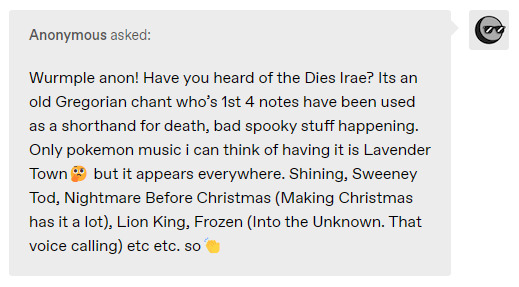
YEAH I was a music major, Dies Irae is one of the few things I do remember from my dreaded 2 years of music history classes and you’re so right it is LITERALLY everywhere!! 😂😂😂
But, I’m actually not sure if it shows up explicitly in Lavender Town?? since Dies Irae is basically “me-re-me-do (-re-te-do-do)” but Lavender Town’s background is something closer to “le-me-so-re“ (in the original key of E minor, it’s C-G-B-F# compared to Dies Irae in the same key which would be G-F#-G-E)
and the main melody is “me-do-me-re-do-so-(lower) la” (starting with G-E-G-F#-E) -- it’s kind of like, backwards dies irae?? with a passing tone in there 🤔🤔🤔
ANYWAYS I digress, the more important thing is:

FSKJDFH it could be that dies irae is a universal constant because the Unown liked it so much that they weaved it directly into the world!! professor tulip totally has her work cut out for her, I wonder if she would have wanted a Sound type classification for moves instead of just calling them Normal? 🤔🤔🤔🤔
as for me I think I just heard the “mm whatcha say” song at that point 😂😂😂
#oceandi answers#anonymous#echo#others' ocs#long post#ignore my music analysis I pulled out the virtual piano to triple check my own solfege 😂😭😂#also I know gregorian chants were modal and using solfege isn't like EXACTLY accurate to those since they're based on specific notes and don#don't have a movable 'do' (which is. so stupid movable do is the most useful tool ever and I never memorized the modes correctly 🙄🙄🙄)#BUT it#s close enoug#h#more on that. actually. bc i'm sick#as a treat#modes are SO important to blues and jazz and I wish I had memorized them well but like jesus christ I hate memorizing them so much skjdfsjdk#oh you want me to remember what the difference is between the 3 different ones that have 'dorian' in the name?? ? ?? well too bad yes I'm a#professional YES I still say 'FACE' to remember the spaces of a staff if I'm forced to think about it
15 notes
·
View notes
Text
Operational Modal Analysis of the Artemis I Dynamic Rollout Test
Operational modal analysis (OMA) techniques have been used to identify the modal characteristics of the Artemis I launch vehicle during the Dynamic Rollout Test (DRT) and Wet Dress Rehearsal (WDR) configuration prior to launch. Forces induced during rollout and on the launch pad are not directly measurable, thus necessitating a unique approach. NASA is developing […]
from NASA https://ift.tt/2V4NoCE
0 notes
Note
any controversial thoughts on psychoanalysis?
now why would you just assume that about me. yeah though. psychoanalysis gets a lot of shit these days for being, like, 'subjective' and 'not verifiable' and 'kind of made up and prone to bias' and so forth. and a lot of that is basically true imo but it's equally true of today's more respectable talk therapy methods, and critics of analysis really lose me when they start caping for therapeutic modalities that are like, literally only 'evidence-based' insofar as they're endorsed by nhs-funded studies run by people who make their careers off promising to reduce welfare rolls. like lmao.
also, "psychoanalysis" is obviously a pretty broad term encompassing a lot of different theories but in general, these modalities tend to be marked by an emphasis on exploring and accepting internal conflict and contradiction (this is the import of formulating the subconscious, mechanisms of defence & repression, &c) in a way i personally find a lot more useful than the kind of post-70s self-help style of, like, "think better, feel better" and the focus on 'practical strategies' for overcoming your dysfunction or whatever. like i'm so tired of that sort of presumption of what a 'healed' or 'healthy' psyche looks like, as though we are all striving to reach a condition in which we no longer admit of contradiction or self-negation or abnegation. i think most psychotherapy that tries to consciously excise the spectre of psychoanalysis just ends up falling back on this sort of relentlessly positive & positivist understanding of the psyche that is totally incapable of dealing with any kind of interior dialectical process or multiplicity of identity. it sucks so hard and makes me feel a thousand times more miserable and insane than old man freud ever could. reichian revival when ‼️
86 notes
·
View notes
Text
How to read a birth chart part 2
Click here to read 'How to read a birth chart part 1'
Analyze chart patterns: Look for patterns within the birth chart, such as stelliums (clusters of planets in the same sign), T-squares, grand trines, or yods. Chart patterns provide valuable insights into the individual's inherent strengths, challenges, and potential life themes.
Consider planetary dignity: Explore the concept of planetary dignity, which refers to a planet's strength or weakness based on its zodiac sign placement. Planets in their own signs (domicile) or exalted positions tend to express their energy more harmoniously, while planets in their detriment or fall may face challenges in their expression.
Assess the chart's elemental balance: Examine the distribution of the four elements (fire, earth, air, and water) within the birth chart. A balanced distribution indicates a well-rounded individual, while an imbalance can reveal areas of focus or potential challenges in certain elemental energies.
Explore harmonic charts: Utilize harmonic charts to delve deeper into specific areas of life, talents, and potentials. Harmonic charts, such as the progressed chart or the Navamsa chart in Vedic astrology, provide additional layers of information and insights into various aspects of the individual's life.
Study the asteroids: Consider incorporating the asteroids into your analysis. Asteroids like Chiron, Juno, Vesta, and Pallas Athena add nuance and depth to the interpretation, revealing specific areas of healing, relationships, career, and wisdom.
Use astrology software or online resources: Take advantage of astrology software or online tools that generate detailed birth chart interpretations. These resources can provide additional insights, especially when you're just starting or need a different perspective on certain placements or aspects.
Combine astrology with other modalities: Expand your approach by integrating other modalities, such as psychology, mythology, numerology, or tarot. These complementary disciplines can offer different angles of interpretation and provide a more holistic understanding of the individual's chart.
Study famous birth charts: Analyze the birth charts of well-known individuals to gain insights into how astrological placements manifest in real-life scenarios. Studying the charts of celebrities, historical figures, or people you admire can deepen your understanding of astrology and offer practical examples of chart interpretation.
Seek mentorship or join astrology communities: Consider connecting with experienced astrologers, either through mentorship or participation in astrology communities and forums. Engaging in discussions, seeking guidance, and exchanging insights with fellow practitioners can greatly enhance your skills and broaden your perspective.
Keep learning and practicing: Astrology is a lifelong journey of learning and exploration. Continuously study astrology books, attend workshops, and engage in ongoing self-study. Regularly practice chart readings, reflect on your interpretations, and refine your techniques over time.
Remember, the interpretation of a birth chart is a deeply personal and intuitive process. As you gain knowledge and experience, trust your own unique insights and interpretations while staying open to different perspectives. The more you practice and engage with birth charts, the more refined your reading skills will become.
#witchblr#witchcore#witchcraft#witchlife#white witch#beginner witch#witch tips#grimoire#birth chart#birthcharts#birth chart explained#birth chart tips#book of shadows#spirituality#astrology
198 notes
·
View notes
Text
Astrology Study Guide
This study guide aims to provide a comprehensive understanding of astrology, its diverse applications, and its impact on various aspects of life, culture, and society.
Basic Astrology Concepts:
Zodiac Signs and Meanings
Planetary Movements and Retrogrades
Elements and Modalities
book rec :
"The Only Astrology Book You'll Ever Need" by Joanna Martine Woolfolk
Natal Chart Interpretation:
Understanding the Houses
Significance of Planetary Placements
Importance of Aspects
book rec :
"Astrology for the Soul" by Jan Spiller
"The Inner Sky" by Steven Forrest
Astrological Techniques:
Transits and Progressions
Solar and Lunar Returns
Synastry and Composite Charts
book rec :
"Planets in Transit" by Robert Hand
"Predictive Astrology: The Eagle and the Lark" by Bernadette Brady
Advanced Astrological Concepts:
Asteroids and Chiron
Midpoints and Harmonics
Planetary Nodes and Part of Fortune
book rec :
"Chiron and the Healing Journey" by Melanie Reinhart
"The Combination of Stellar Influences" by Reinhold Ebertin
Astrological Practices:
Chart Calculation and Drawing
Interpretation and Analysis Techniques
Application in Personal and Professional Settings
book rec :
"The Professional Astrologer" by Oner Doser
"The Astrology Podcast" by Chris Brennan
Historical Astrology:
Evolution of Astrological Practices
Cultural and Historical Significance
Influence of Astrology on Society and Culture
book rec :
"A History of Western Astrology" by S. J. Tester
"Hellenistic Astrology: The Study of Fate and Fortune" by Chris Brennan
Ethics and Responsibility in Astrology:
Confidentiality and Trustworthiness
Maintaining Professionalism and Boundaries
Empowering Clients and Practitioners
book rec :
"The Ethics of Caring" by Kylea Taylor
"Astrology, Psychology, and the Four Elements" by Stephen Arroyo
Astrology and Psychology:
Psychological Astrology Principles
Use of Astrology in Counseling and Therapy
Integrating Astrological Insight into Self-Discovery
book rec :
"Astrology for the Soul" by Jan Spiller
"The Astrology of Fate" by Liz Greene
Astrology and Predictive Techniques:
Timing Events with Transits and Progressions
Forecasting Techniques and Tools
Preparing for Potential Challenges and Opportunities
book rec :
"The Art of Predictive Astrology" by Carol Rushman
"Solar Arcs" by Noel Tyl
Astrology in Modern Context:
Popularity and Relevance in Contemporary Culture
Astrology in Media and Entertainment
Social and Online Astrological Communities
book rec :
"Astrology, Karma & Transformation" by Stephen Arroyo
"The Astrology of You and Me" by Gary Goldschneider
Helpful sites/apps :
astro.com
astromatrix.org / astromatrix app
Pattern app
Co-star app
90 notes
·
View notes
Text
ATEEZ Scorpio Analysis

Hello and welcome to quite possibly the silliest post I’ve made to date! I’ve spoken at length about Ateez and the relationship with their Scorpio placements, but for whatever reason, I wish to rank them and find the chiefest Scorpio amongst them. So without further ado, let’s get into it!
Disclaimer: As per usual, traditional astrology and rulership applies. This post especially is just for fun. If you think I’m wrong, feel free to argue in the askbox.
Pre-Game:
So first, I’ll explain the how of the game. We’re going to be measuring the dominance of the three major components the rulership of Scorpio: Planet (Mars), Element (Water), and Modality (Fixed). We’ll be using the very convenient Dominants tab from the Natal Charts available on astro-seek to get our base numbers and weight them accordingly. I did my best to find a “fair” way to account for everything, but there’s a reason they say “lies, damn lies, and statistics”.
Here’s what the table I’m working with looks like, using Ateez’s group natal chart as an example:
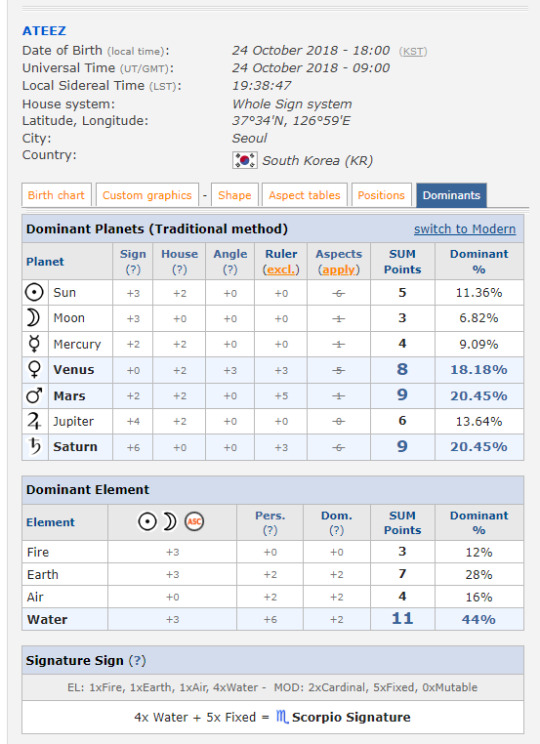
I’ve generated one for each of the members, but they're not included with this post so as to not clog up the view. The website itself explains each column and how they come up with the numbers, but in short, significance is given to each planet based on where it is, if it’s being ruled by a sign of rulership/exaltation/etc, whether its in a house of corresponding rulership… we will be ignoring aspects for this, as some of the birth times we have are approximations, which can lead to incorrect aspect degrees..
For scoring, planets will be weighted at 40% of the total, with element and modality each being worth 30%.
As a refresher for those who don’t keep this information in their brains, here are the Scorpio placements between members:
Hongjoong: Sun and Venus
Yunho: Mars and Rising
San and Mingi: Mars
Wooyoung: Mercury
Jongho: Mercury and Venus
Yeosang and Seonghwa have none, but they have quite a bit of Mars and Water influence, so don’t write them off just yet!
**I am operating this under the assumption that Jongho is a Taurus Rising. I’ll address it more at the end, but ultimately, there wasn’t a huge difference between my top 3 guesses and his final score, so I just ran this with the one.
Round 1: Planets
Who has the most outright Mars influence? Well, this one should come as no shocker:


Yunho and Seonghwa are very close point total wise, but for Yunho, his Scorpio Mars in the first house is his strongest placement by a margin of 4 points (his Taurus Venus coming in second at 10 points), Despite all of his Aries Mars influence clocking 13 points, Seonghwa’s Aries Sun and Cancer Moon are also weighty factors in his totals at 12 points apiece, bumping his point total up, but his percentage down.. San’s Scorpio Mars is actually tied for influence with his Leo Mercury, since it’s ruling his ascendant.
Mingi’s Scorpio Mars is tied for second in his dominant planets with his Leo Sun, but both are overshadowed by his Cancer moon by a mere point. Wooyoung actually has all of 9 points, but as it turns out, his Venus in Libra in the first weighs in at a whopping 18 points (the most points of any member, causing his Mars to only rank 3rd in his dominant planets. Hongjoong’s Jupiter in Pisces is actually doing a lot of the heavy lifting in his influence, but his Scorpio Sun and Mars in Virgo help keep him from falling into last. Finally, Yeosang is bringing up the rear with 6 points being carried by his Aries Ascendant placement
All in all, every member of Ateez has Mars as no less than their 3rd place influencing planet, which is honestly quite impressive.
Round 2: Elements
Water placements! We’re looking at Scorpio, Pisces, and Cancer. No crazy weighing this time, we’re just checking to see who has the most water in their chart.


Most of these rankings are being carried by the plethora of Cancer Moons (Mingi, Seonghwa, and Yeosang), with Hongjoong getting a chance to shine by virtue of his Scorpio Sun/Venus and Pisces Jupiter. Almost everyone actually has water as their top element or is tied for top, with San and Wooyoung being Earth/Water and Air/Water
... except Seonghwa, who despite getting second place, is strictly fire dominant.
(And now I’m laughing because a whole bunch of water dominants debuted with a pirate concept 😂)
Round 3: Modality
Easy peasy, we’re looking for fixed signs in the natal placements + ascendant. For a refresher, these are Taurus, Leo, Scorpio, and Aquarius.


San’s Leo and Taurus placements clench the win for San in this category, with 5 placements out of 8 being fixed, compared to Yunho and Mingi’s four, though all 3 are fixed dominant. Meanwhile, this is where Seonghwa finally gets penalized for all of his Aries/Cancer energy, as his only fixed placement is his Aquarius Venus. Hongjoong and Jongho both have predominantly Mutable placements, while Wooyoung, Yeosang, and Seonghwa have significant Cardinal energy.
A note on Signature Signs:
If you take the natal 7 plus ascendant and calculate the most modalities and elements (not the same way as the Round 2), some people will end up with a signature sign. Of the Ateez members, 5/6 out of 8 (Jongho being a maybe) actually manage to snag one:
Hongjoong has a Pisces Signature (3 Water + 4 Mutable)
Seonghwa and Yeosang both have Aries Signatures (4 Fire+5 Cardinal and 3 Fire+5 Cardinal respectively).
Yunho has a Scorpio Signature (3 Water+4 Fixed),
San has a Taurus Signature (3 Earth + 5 Fixed)
Jongho (w/ an assumed Taurus Rising,) is a Gemini Signature (3 Air + 3 Mutable).
Mingi and Wooyoung both have ties in their elements, with a 3/3 split on Earth/Water for Mingi, and 2/2/2/2 for Wooyoung across all elements.
I couldn’t figure out how to weigh Yunho's bonus Scorpio Signature into this contest, but in the end it didn’t matter…Because the grand Scorpio of Ateez is still Yunho
Final Scores:
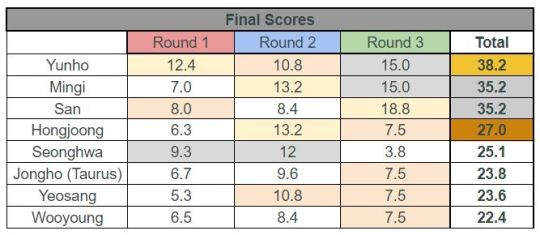

Yunho was the only member to get Top 3 in all 3 rounds of scoring, and really his Mars strength from round 1 could not be surpassed. In my attempt to make this fair, I tried different ways of weighing this (33% even, 50/30/20, etc.) and Yunho comes out on top every time. But once again, Scorpio Rising ruled by a Scorpio in Mars- was there ever any doubt?
By this weighting, Mingi and San tie, but if you switch to 50/30/20 Mingi squeaks out above San, while 50/25/25 has San edge out Mingi. Ultimately I’m fine with the weighting I landed at, as I think it’s pretty clear that these 3 are leagues ahead of the rest. Hongjoong and Seonghwa will actually tie in 50/30/20, but for the most part Hongjoong sits above Seonghwa. Meanwhile Wooyoung never clears last place, with Jongho and Yeosang sitting somewhere above him.
Final Tidbits:
-Now, as previously stated, a Taurus Rising for Jongho is just a guess, but with the exception of a Scorpio Rising (which I ranked at 5/12 for likelihood), the top 3 rising options sit at about the same place in the chart, so I went ahead and kept Jongho on here. I have all 4 on my master document that I will post at the end
-If you run Ateez’s group natal chart against all the members, it often will rank even higher than Yunho, depending on the weighting.
-I’ve included my own Scorpio ranking in the master document. Do with that as you will.
If you’ve made it to the end of this, I greatly appreciate you and your time. Hope you’re having a wonderful Scorpio Season!

#ateez#ateez astrology#scorpio#kpop astrology#hongjoong astrology#seonghwa astrology#yunho astrology#san astrology#yeosang astrology#mingi astrology#wooyoung astrology#jongho astrology
51 notes
·
View notes
Text
Reflecting on his time making the original “Heat,” which starred Val Kilmer, he smiles. “I could not figure out how Val Kilmer could tolerate being Val Kilmer,” he says. “In any scene, an actor and director do scene analysis. What is the action or what does this character want? Sometimes, it’s in the text; sometimes, it’s in the subtext. Val would have seven or eight different reactions and modalities, every one of which was great. I couldn’t imagine having such artistic range and depth — more than it’s possible to control.”
19 notes
·
View notes
Note
Hi. Firstly, I want to thank you for sharing many analysis posts and answers here. They are very interesting and insightful. It gives me a lot of motivation to continue studying mandarin!
I've seen your post about Hua Cheng's speech pattern which is the topic that I'm always interested in. You mentioned that his speech is usually polite and concise. Many of the words/phrases he uses sound old-fashioned by modern day standard. I first read TGCF in English, but I've been trying to read the simplified CN version recently. I noticed sometimes HC uses modal particles. For example,
“不错。我不是说了吗,谁也惦记着我这地方呢。戚容想鬼市不是一年两年了,可偏生他最多也只能想想,眼红得紧,所以时常派些跟他一样的废物来捣乱。见怪不怪咯。”
花城微微挑眉,传音道:“撒谎咯。”
那少年嗤笑道:“嗯,水横天嘛。”
I'm still not familiar with how modal particles are used, but the general impression I got about modal particles are that they make the sentence not concise. Like, you reply someone with 好 instead of 好啊 if you want to be concise. Am I correct?
Also, is it true that 咯 is used instead of 了 to convey a cheerful manner and is normally used by girls and children?
I would like to hear your thoughts about this. Thank you very much!
Hi! :) Thank you for your kind words, you're right that modal particles make the sentences less concise, but sometimes they're necessary to convey the speaker's mood, tone, or even personality trait. I also understand how modal particles can be difficult because they're very flexible and their implications sometimes depend entirely on the context of the sentences.
咯 adds a playfulness and lightness to speech, and with the first quote you mentioned, it expresses Hua Cheng's flippant and scornful attitude, and emphasizes the expected nature of Qi Rong's troublemaking. 咯 in the second quote softens the tone of sentence and makes it more playful, since Hua Cheng is basically flirting with Xie Lian. 嘛 in the third quote shows Hua Cheng's irreverent and scornful attitude. So you see modal particles here are necessary in conveying Hua Cheng's personality. Its true that 咯 sounds more cheerful than 了, but I don't think it's restricted to being used by girls and children.
14 notes
·
View notes
Text
buck's big three
i see a lot of people headcanon buck as a cancer, and i think this is probably largely due to the fact that oliver stark is a cancer and some of that bleeds into his portrayal of buck. i've never seen him that way, though, and i thought it could be fun to do a little analysis of his "big three" — his sun, moon, and rising.
this is all for fun!! he is a fictional character and if you headcanon him as something different, that's chill and i would LOVE to know why!!
☉ in Gemini | ☾ in Cancer | ↑ in Leo
Sun in Gemini
Before everyone starts booing that I didn’t make him a cancer, he’s a cancer moon.
Gemini is a mutable air sign. Air signs are intelligent, open-minded, and sociable, and with the mutable modality, gemini is especially witty and curious. Geminis are often stereotyped as being two-faced, and while it is true that there is a duality that is unique to the sign, the dual nature shows itself more in their ability to be open-minded and flexible, than conniving liars.
(Not Gemini slander on this blog!)
Geminis are extroverted people with an insatiable curiosity. If they aren’t being challenged intellectually, they’ll often get bored very quickly. They’re quick-witted people who need social interaction, their mutable modality making them quick at adapting to new situations and new friendships.
We see this a lot in Buck. The Sun rules our core, our values, a huge part of who we are. There’s a reason most people only know of their sun sign, but not the rest of their natal chart (though you should look it up if you never have). Outwardly, Buck is very sociable. He’s likable, he’s a little immature, but he craves attention, affection, and validation from the people he cares about.
He’s also a bit hard to read. Because of the dual nature of gemini, it’s hard to know what they’re truly feeling. They’re people pleasers with a need to be liked by everyone in a room, and often end up hiding what they truly feel. Their restlessness and inability to open up makes it difficult to really get to know them.
They can be emotionally closed off, but because of Buck’s moon in cancer, all of the typical superficiality of a gemini sun is nowhere to be found. Geminis have an independent quality to them from their element, and, at their core, they're fun and charming, and that’s very much Evan Buckley.
Moon in Cancer
(Everyone cheered.)
Cancer is a cardinal water sign. Water signs are sensitive, emotional, caring, and their love runs deep. The cardinal modality is the leader of the quadruplicities, and they are quick and ambitious. The moon is at home in cancer, as it is cancer’s ruling planet.
The moon is a reflection of our innermost personal self. Where the sun is outward expression, the moon is who we are when we look inward.
Buck’s very emotional, and he clings. Moon in cancer people have a tendency to do that—to not let go of the past, especially when the memories are emotional. This, combined with his sun in gemini and the need to please, often leaves him more vulnerable to rejection and when rejection does come, it often leaves him reeling.
The hurt from this rejection may linger longer for a cancer moon than if this placement was in any other sign. Because of their memory and the hold they have on, well, just about anything in their life, cancer moons will dwell on this hurt, and dwell on the past.
They can be insecure. Combine that with the easy, outgoing, confident nature of the gemini sun, and it’s easy to see how this creates internal conflict in his character. The nature of his moon is sensitive, it’s often moody, and it treats everything with an intensity the gemini sun doesn’t understand.
On the lighter, more positive side, cancer moons love and care very deeply. Combine that with the curious, intelligent nature of the gemini, and you get things like an adaptable skateboard, or Buck organizing Christmas at the firehouse.
Cancers are loyal, and if you manage to make a friend in a cancer moon, you will have them for life.
Ascendant in Leo
I’ll be honest, I wasn’t entirely sure which sign I felt like his rising should be in, but I knew it had to be headstrong and proud, and if that isn’t Leo, I don’t know what is.
Leo is a fixed fire sign. The fire makes these people excited, fiery, and prideful, and the fixed modality makes them stubborn and headstrong.
Your ascendant is how you present yourself to other people. It’s the first impression you give to someone, and we see this best when Eddie is introduced. Buck was immediately trying to show off—possessive of his territory as leos often are—and he was immediately distrusting of Eddie, not because he seemed incompetent, but because Buck was insecure about what that meant for him.
Leos are the lion, they’re vain, but a leo rising is magnetic, you can’t help but be drawn to them. We see that with Taylor in Dosed, how charismatic he is and how attracted to him she seems.
Speaking of vanity, leos are quietly insecure, and deeply self conscious. How they look is important, how others perceive them doubly so.
They can also be childish and immature, prone to posturing and temper tantrums; an insecure, already bothered leo can work on a hair trigger. It wouldn’t take much for one to be, say, confronting someone else in a locker room because they felt threatened.
They’re also enthusiastic optimists, and overestimate their abilities. We see this with Buck and his recklessness, going into the ambulance to disarm the grenade with Eddie. He had something to prove to both Bobby and the new guy that he was just as good.
Overall, Buck’s big three make him a fun, charismatic, witty character whose love for his family and his friends runs deep. I know a lot of people are very fond of Buck being a cancer sun, but I think a cancer placement in his chart would make much more sense in a planet that rules internal expression.
To the world, on the job, Buck is lively, he’s enthusiastic, and he’s more than a little reckless.
By himself, to the people in his life that matter, he’s vulnerable and sensitive, someone who clings, someone who has a hard time letting go, but who would go to hell and back for the people he loves.
50 notes
·
View notes
Text


Operational modal analysis of the Artemis I dynamic rollout test
Operational modal analysis (OMA) techniques have been used to identify the modal characteristics of the Artemis I launch vehicle during the Dynamic Rollout Test (DRT) and Wet Dress Rehearsal (WDR) configuration prior to launch. Forces induced during rollout and on the launch pad are not directly measurable, thus necessitating a unique approach.
NASA is developing the SLS to support lunar and deep space exploration. SLS is integrated inside the Vehicle Assembly Building (VAB) on the mobile launcher (ML), which supports the integrated SLS launch vehicle during transport to the pad through lift-off. The ML also provides the fuel, power, and data umbilicals running to the SLS and Orion Multi-Purpose Crew Vehicle (MPCV), as well as crew access to the MPCV crew module.
The ML weighs ~10.6 million pounds and is over 380 feet tall. In the spring of 2022, the SLS was transported on the ML from the VAB to Launch Pad 39B (Figure 1) using the NASA crawler transporter (CT) to make this 4.2 mile trek, which takes ~8 hours. The CT alone weighs ~6.3 million pounds.
Although the rollout environment produces relatively small launch vehicle structural loads in comparison to launch and ascent loads for most structures, the induced loads are fully representative of all loading across the entire vehicle, which is not feasible to replicate using localized shakers as was done in the Integrated Modal Test.
As mentioned, forces induced during rollout and on the launch pad are not directly measurable, and OMA techniques were used to identify the modal characteristics of Artemis I in the DRT and WDR configurations. WDR, which typically includes vehicle fueling and other operations to demonstrate launch readiness, included several days of on-pad operations.
Data collected for the WDR configuration, with partially filled core fuel tanks and without the CT under the ML, provided engineers another model configuration to check.
Acquisition and processing the data from more than 300 accelerometers located on Artemis I, ML, and CT was accomplished by a cross-program team of engineers and technicians from across the Agency, including from SLS, Exploration Ground Systems, and the NESC. Using analytical techniques developed from previous rollout tests combined with new data-processing methodologies, the team processed data from preselected CT speed increments during rollout and on-pad during WDR.
By making the necessary modifications to the integrated models to match both the DRT and WDR configurations, the team was able to use those results to help make sense of what was being seen in the test data. This proved to be required for OMA testing on this structure, given the type of complex excitation that was being observed.
TOP IMAGE....Artemis I at Launch Pad 39B. Credit: NASA
LOWER IMAGE....Artemis I Rollout to Launch Pad 39B. Credit: NASA
12 notes
·
View notes
Text
Vegas speaking English in ep. 13
As @respectthepetty pointed out, in Kinnporsche, English seems to be used when a character is being deceitful. This interpretation, however, in my opinion doesn’t work with Vegas’s use of English in episode 13.
I’m going to try to analyze why he might have used English in the specific moments that he did. First, some linguistic background (sources at the bottom):
When bilingual speakers switch from one language to the other, that’s called “code-switching”, and it can happen for many reasons. Since multiple languages are active in the bilingual speaker’s mind, a control process is required to select the appropriate language for the situation at hand and filter out the other language. However, heightened emotion may interfere with this process, because in emotional contexts one has a lower capacity for cognitive control. (1) This means that a bilingual speaker may be less able to control their code-switching and thus do it spontaneusly, without meaning to, just because their brain is too preoccupied with their emotions to successfully filter out the “unwanted” language.


This seems to me to be what happened in these two instances where Vegas speaks English. In both he is overcome with emotions: guilt, grief, love, frustration, all mixed in. He’s so overwhelmed, it's no wonder he can't control his code-switching.
But this explanation doesn't hold up for the line spoken in English at the very beginning of the episode, in a situation where Vegas seems to be relatively relaxed:

Even though Vegas is bilingual,I am assuming that Thai is the language he grew up speaking the most with his family, and the language through which most of his familial and emotional bonds were formed. Thus, it is very likely that he has a higher emotional attachment to Thai compared to English. For this reason, for the purpose of this analysis I will refer to Thai as is his first language and to English as his second language.
Studies into the way bilingual speakers process emotions through language have shown that they have a lower sensitivity to emotionally charged stimuli presented in the second language compared to ones presented in the first language. When processing the second language, there is a psychological distance. (2)
Up until now, that psycological distance meant that Vegas was lying, or being a little shit. But in this situation? I think it’s quite the opposite. Vegas is laying his soul bare for Pete. He’s probably feeling more exposed than he ever has in his life. What he's saying is so true, and raw, and vulnerable, that he can't bear to say it in Thai. It would make it too awkward, too real. This is the reason why, in my opinion, he switches to English.
______________________________________________________________
Sources: dude trust me. just kidding lol
(1): Aya Williams et al (2019). Why do bilingual code-switch when emotional?
(2): Katarzyna Jankowiak & Paweł Korpal (2017). On Modality Effects in Bilingual Emotional Language Processing: Evidence from Galvanic Skin Response
#kinnporsche#vegaspete#kinnporsche meta#vegaspete meta#i know that it's ridicolous that im putting sources for a stupid meta post as if i was writing a fucking thesis but i just feel weird not#mentioning where i got the info from ya know?#kinnporsche the series#vegas theerapanyakul
256 notes
·
View notes
Text
GUSTAV MAHLER: A PARTIAL NATAL CHART ANALYSIS (HOUSES 1-6)
🧿DO NOT STEAL MY WORK OR KARMA WILL FIND YOU.🧿

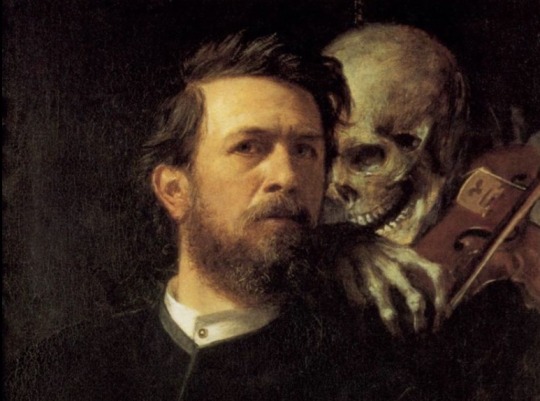



hey guys :) i was searching through my old projects and i found this! i did this analysis for a creative project in order to get my position as drum major. if it seems too over-explanatory, it’s because i was describing all of this to people who didn’t know anything about astrology. also, this was written like a year ago, so my knowledge on astrology and placements has definitely expanded since then. if anything seems “out-of-date,” that’s why. either way. i hope y’all enjoy!! i had a lot of fun making this post to share this analysis with you all!! :) <3 (also i do not know the titles of these paintings. i do know that the middle one is mahler, though! so if anyone can tell me the names and their artists, it would be much appreciated!!!!)
WHO WAS GUSTAV MAHLER?
Gustav Mahler was a composer during the romantic period. He is of Austro-Bohemian decent, and is best known for his 10 symphonies. A fun fact about him is that a the main tune for “Be Our Guest” from Disney’s Beauty and the Beast came from his Symphony No. 3. Like most amazing artists, he didn’t become famous until years after his death. The performance of his music was banned in most of Europe during the era of Nazi rule and later rediscovered by new listeners. Since then, he has become one of the most recreated composers and has since kept this position going into the 20th century. (source(s): https://en.m.wikipedia.org/wiki/Gustav_Mahler, https://www.cartoonbrew.com/disney/be-our-guest-and-mahlers-symphony-no-3-54610.html)
INTRODUCTION:


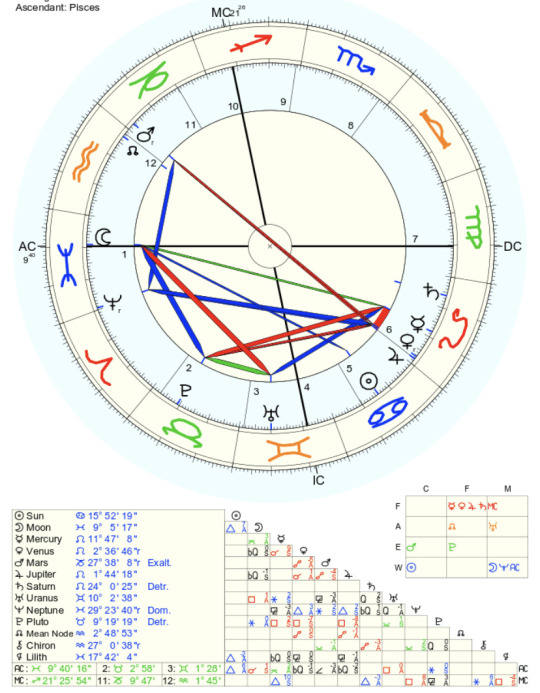

This is Gustav Mahler’s birth chart. He was born on Saturday, July 7, 1860, in Kalischt, Czech Republic at 10:15 p.m. Everything in a chart has an important meaning; from the degree, to the house, to the sign, to the planet. To give a breakdown, the top left of the screen is his birth time information, below that is his planet’s signs and degrees, the tiny chart below that is the elements and modalities in his chart, and the tiny triangle under that are his chart’s aspects. To the right of all of that, is his chart. Each chart has 12 houses. These houses start from the AC, or the ascendant. However, today, I will only be evaluating 6 out of the 12 houses.
As you can see from Mahler’s chart, his ascendant is in Pisces at 9°. His first house also contains his Neptune, which is the planetary ruler of Pisces. From the other charts of talented musicians that I have evaluated, a lot of them seem to have heavy Pisces influence. This even extends to the talented musicians within our own community. (3 of excellent musicians in the band) are all Pisces suns. My brother has multiple planets in Pisces, which forms a stellium in his chart. A stellium is when 3 or more planets are in a sign or when 3 or more planets are in a house. Sometimes, these 3+ planets can ALL reside in the same house, which focuses a ton of energy of that chart towards that house.
STELLIUMS
In reference to stelliums within Mahler’s chart, he has a stellium in Leo which resides in his 6th house. His Venus, Mercury, Saturn, and Jupiter are all in Leo and all reside in his 6H.
However, we will get to what all of that means later. As of right now, I want to break his chart down house by house, planet by planet, sign by sign.
HOUSE 1: THE HOUSE OF SELF
So, let’s start with the first house. As I said before, Mahler has a Pisces ascendant, so his first house is in Pisces. His first house contains his Neptune at 29°. The first house represents how we see ourselves and others’ first impressions of us when they meet us. The planets or sign of this house can ultimately affect our personality, and the 1H is The House of Self.
Neptune is the ruler of illusions and delusions, intuition and dreams, mysticism, the imagination, mental illness, the unknown, and is a major pinpoint of isolation (along with Saturn). This planet is also said to rule celebrities, as they give the public an illusion of what they’re like vs. what they’re actually like. His Neptune is in its house sign of Pisces, so the sign and the planet are in harmony meaning they will act in the same mannerisms. However, his Neptune is at 29°. 29° is the highest degree at which signs in planets can go to, making this a critical degree. 29° emphasizes the energy of the planet and its rulerships and can even signify fame. This degree is ruled by Leo.
Mahler was known, according to Connolly Music, to “suffer from skepticism, nervous tension, and an obsession with death.” The fact that Neptune is so prevalent in his chart is one of the main reasons why he is this way. The themes of Neptune and its critical degree, as you can see, affected his overall personality.
About the unknown and mysticism part of Neptune, Mahler hid from his wife the fact that he was Jewish and even converted to Christianity in order to have a successful conducting career. Alma, Mahler’s wife, was insanely anti-semitic, and never knew he was Jewish for a long time.
About the isolation part of Neptune, Mahler had a composition hut in Austria in which he used to finish his Second and Third Symphony and a few songs from his Des Knaben Wunderhorn. Funnily enough, this hut was positioned by Lake Attersee. Neptune, in Roman mythology, is known as the God of Freshwater and the Sea. Not only did he like to work in seclusion, he also liked to work near a body of water. He was also known as “an avid swimmer and mountain walker.” It’s just very funny for me to see things like this work hand in hand.
HOUSE 2: THE HOUSE OF VALUE
Mahler’s second house is in the sign of Taurus. While it should be in Aries, Mahler has what is called Intercepted Houses. This is when the sign of a house skips or repeats itself. However, this doesn’t mean that Aries does not exist in Mahler’s chart, however all 30 degrees of it is in the 1H. The reason why this happens is because the northern and southern latitudes of the 12 houses are not evenly spaced. This results in a sign being hidden and not easily accessible, though it is still there.
In this case, the house intercepted is in Aries. Aries governs over confidence and passion. It is ruled by Mars. As we can see by the description of Mahler’s personality, he suffered from skepticism and feared the unknown. He was unable to channel that Martian energy in his chart, thus leaving him unconfident.
Moving forward, the second house governs over personal finances, material items, self worth, and inner desires of gain. This house could also express one’s system of values. Mahler has his Pluto in the 2H in Taurus at 9°. Taurus is ruled by Venus and governs over the 2H, so it's right at home here. Pluto is the planet of destruction and transformation. When this is in the house of finances, a lot can go wrong as well as right. In terms of money, this route can take extreme rises as well as extreme falls. The people who have this placement can either be born into humble circumstances or be born into vast wealth. Mahler, of course, was born into humility, and had multiple rises and falls in his income. People with this placement also tend to have a small view on themselves and have a desire for control. This was very evident in the way that Mahler was described.
Since his 2H is in Taurus and intercepted houses are in effect, this means that four of the houses that continue after will be under their traditional sign of rulership. In Mahler’s chart, this is his second, third, eighth, and ninth.
HOUSE 3: THE HOUSE OF COMMUNICATIONS
The third house in Mahler’s chart is in Gemini. The third house rules communication, siblings, early education, perception, and transport. His Uranus resides in this house at 10°. Uranus rules everything eccentric, unpredictable, and creative/scientific brilliance. Having his Uranus in the 3H is a symbol of some kind of genius, though they often struggle in school.
Many reports say that Gustav Mahler was very “unreliable” in his academic school work. In order to fix this, his father had sent him away to the Newtown Gymnasium in Prague. Then, he ended up going to the Vienna Conservatory in order to study music. Here, Mahler’s rebellious flag flew as well, though he graduated. This is a fine example of transportation and struggling in school that Uranus so represents in the 3H.
Another example of his Uranus in the 3H working is that his siblings and their relationship with them weren’t “conventional”. His sister, Justine, had extreme possessiveness over Mahler and even went to extremes to make sure his romances were ruined. This was before he met Alma and told Justine that her behavior couldn’t continue. This encounter ruined Justine’s relationship with her brother. Many of Mahler’s siblings died during his early childhood including his older brother, who would’ve been the oldest of the 14 had he not passed. He also assumed responsibility for all of his surviving siblings after the death of his parents in 1889. This “unusual” responsibility can also be represented by the 10° that Uranus is in. 10° is under the rulership of Capricorn, which is ruled by Saturn. Saturn rules responsibility.
HOUSE 4: THE HOUSE OF HOME
Again, intercepted houses are at play here. Mahler’s fourth house is also in Gemini. There is not a planet in this house, meaning that only the sign is affecting this house. This also means that there is less tension pointed to this house in his chart. The 4H rules family, home, parents (specifically the mother), and the emotional base of our satisfaction.
Since Gemini is in this house, Mahler’s family life and home was constantly changing. This is very evident in his constant moving-about during his early childhood. Gemini in this house can also talk about a specific connection between one parent, though emotions in this sign are often rationalized. Mahler had a strong relationship with his father, who supported him in what would eventually be his career (music). He cared a lot for Mahler to make a stable income and put this first. Funnily enough, the 4H opposes the 10H, the house OF career.
HOUSE 5: THE HOUSE OF PLEASURE
When we talk about the 5H, we usually associate it with pleasure. This pleasure is usually derived from self-expression, creative hobbies, desire, children, and the showing of individuality. This is one of my favorite houses to talk about in astrology and placements here make it all the more interesting. Mahler’s 5H is in Cancer, the sign of emotional/physical well-being and comfort.
Traditionally ruled by Leo, Mahler’s sun in Cancer at 15° is right at home here. To me, the sun shines the brightest here because it’s in its home house. Since it’s the only planet here, it’s definitely giving the most energy.
A great explanation as to how rulership works out in astrology would be how Mahler passed away. The only reason why I bring this up here is because his 5H shows kind of a preview of what he was under before he died.
Mahler found out his heart was defective after his daughter, Maria Anna, died of scarlet fever. The discovery was made immediately after her passing. He was very stressed out beforehand and after her death, expressing his exhaustion was very hard. I believe this took a toll on his health, as he was unable to properly express himself and stress tends to build up in the heart.
He performed his last concert and left for Europe. He then was taken to a sanitarium to be treated. A few days later with no improvement, Mahler passed away. He was buried next to his daughter Anna Maria, as per request, on May 22 with only his name on his tombstone. He said this to be so because “any who come to look for me will know who I was and the rest don’t need to know.”
His death can also be represented in his sixth house, which I will further explain when we get there.
HOUSE 6: THE HOUSE OF HEALTH AND OCCUPATION
Out of all of the 12 houses in astrology, this one is definitely in my top 3 to discuss. The 6H can tell us so much about our potential careers as well as what our health could look like. This house rules health, occuations, and physical limitations. Though this house is traditionally ruled by Virgo, in Mahler’s chart it’s in Leo.
As I said before, Leo rules self-expression. One of the many ways of self-expression is performance. Frankly, if you haven’t noticed, Mahler’s got a lot of Leo in his 6H; he’s got a stellium, so it isn’t exactly surprising that he chose a career where his self most resonated and could be displayed in the public with an artistic flair. He also has his Venus, the planetary ruler of music and all things art, in this house as well at a powerful degree. Venus in his 6H is at 2° . 2° is ruled by Taurus and is often called the degree of power. It’s a very ambitious degree to have and it’s often what we pursue. 2° here under Venus shows that Mahler pursued music and put all of his ambition into it.
Here alongside Venus, are Jupiter, Mercury, and Saturn. Jupiter makes a conjunction to his Venus. Jupiter rules expansion, education, joviality, and abundance. When it is in a positive aspect to Venus, Jupiter enhances and expands Venus’s properties. This is an aspect I see in a lot of musicians as well, so I thought I would mention it here.
Like I said when I was discussing the 5H, there were a lot of factors in the 5H and the 6H that portrayed a preview of what Mahler was under before he passed. Since the 6H rules health, the 6H can tell a lot about the illness that caused Mahler’s death. Like the 5H, there is Leo influence. This again is pointing towards the heart problems that Mahler had with his heart as well as his job as a musician. Whenever my brother told me that Mahler had died of a heart condition, the first thing that caught my eye was his stellium in this house. I told him that it wasn’t surprising considering the huge amount of Leo influence here.
Mahler overexerted himself and then died in a sanitarium. Both of these things are represented by the 6H. When Mahler was on his deathbed, many people went to visit and expressed how much they loved him. Attention is ruled by Leo and Virgo/6H can represent places where health purification takes place. Him also having Saturn here, the planet of long-term effects and karma, indicates that his health issues had a long-term effect on not only him, but the people around him and that his daughter’s death could have been a factor leading to his death as well. All things health related can be pointed to the 6H and I think it is one of the easiest houses to read in astrology.
DEGREES:
Below, I listed some degrees that were indicators of his success and degrees that repeated.
Degrees of Fame and Success within Mahler’s Chart:
Neptune at 29°.
Venus and North Node at 2°.
North Node is our “path” in life and Mahler having this at 2° in Aquarius (ruled by Uranus, planet of eccentricity and community) proved that he was meant to do something that while was different from other people, was still extremely influential. His North Node resides in his twelfth house.
Repeating Degrees:
9°, 21°- Sagittarius Degrees
Sagittarian degrees, like all degrees, add the characteristics of a sign to the body it’s effecting. Sagittarius rules freedom, passion, and intellectuality. Mahler was incredibly passionate about what he wanted to do and he wanted to do it his way. Despite his uncertainty about the people around him and his true identity, he knew he found some sort of comfort in creating and learning about music while having the freedom to do so.
2°- Taurus degrees
2° is the degree of power and has extreme influence. This influence can be used for good or bad, and I’m thankful Mahler used it to elevate his musical career.
CONCLUSION:
I think all of these situations being displayed in Mahler’s chart can show that astrology can have the ability to predict events or tell of events that have already passed. Of course, you still don’t have to believe in everything I said here, I just think it’s neat! I only did 6 out of the 12 houses because this would have been probably 20 or more pages worth of information, and I did not want to make this longer than it already was. Either way, I hope you enjoyed! :)

© thee-achilles 2023
#Spotify#thee-achilles#astrology#astro community#astro tumblr#thee achilles#astro talks#astroblr#astro observations#astrology observations#drabbles#protection#🧿#gustav mahler#musician#romantic period#astrological observations#astrologer#astrology placements#astro notes#astro placements#astrology asteroids#my analysis
50 notes
·
View notes
Note
Hello. Our discussion the other day left me confused about what exactly you consider the term "Leftism" to mean. So as a clarifying example, would you describe the USA Democrats as a "Leftist" party? Thanks
Starting at the direct level, the democrats in the US contains leftists but is not wholly or primarily leftists. Its dumb US stuff, since its a harshly two-party system both republicans and democrats are actually a grab bag of coalitions. At different times the democrats are either cooperating with or opposing their own leftist faction, so its contextual.
I don't find this framing too useful in the modern era honestly. Like yes, Hegel was *sigh, ugggh* right, human preferences are diverse but aggregated social dynamics work such that a 'left-right' binary emerges in almost all socieites. However, its not what self-identified capital-L leftists tend to mean, they treat Leftism as a cohesive, cross-country faction distinct from conservatives, liberals, etc. This made sense at the end of the 19th century - opposition to imperialism, support for expanded franchise, legalizing unions, etc, made a unified political platform in Europe. But political faction aren't a constant, its downstream of the political, social, and economic forces of the day.
These days I don't see a strong "leftist" political party in the same way of much note. On some topics is because its too diffuse - oh leftists support queer rights? So do most liberals, so do a lot of conservatives even, progress on queer rights wasn't wholly or even primarily a leftist achievement depending on the country. On others its because its way too specific - are the german environmentalists shutting down nuclear power plants to prop up coal plants leftists? They think they are, to me they are fools. For an issue near and dear to me, left-NIMBYs think they are preserving their communities, I think they are gatekeeping low income housing and degrading our cities. Are the leftist for queer rights also NIMBYs? What do they think of open borders? There isn't a coherent platform of leftism even within countries, let alone across them.
(A lot of this is because the goals of 19th century leftism were achieved in many fronts, though certainly not all - expanded franchise, end of imperialism, large welfare states, etc. Those solutions ofc brought ther own problems and history marched on)
Instead I view modern capital-L leftism as primarily a cultural thing - lots of Against Capitalism energy, but when you are in office debating budget allocations between transport modalities or immigration regulations suddenly that energy provides contradictory answers. It does exist, im not saying its all vibes; instead when analysing the political party of country X, its not a simple question. The Democratic party in America has its left moments and it has its liberal moments and its straight-up right moments; the Socialist Party of France has had gone back and forth on what that actually means because it turns out governing is hard, and has done a ton of conservative stuff in its day.
I suppose it is worth mentioning that for some forms of leftism it *is* all vibes - no actual plan for obtaining and utilizing political power, just vague hand-waves at ~revolution~ that is never going to happen and would probably be a disaster if it did. This isn't the majority by any stretch, its often an insult hurled at actual leftists who absolutely are doing real work. But they do exist - they aren't political figures at all, and I don't consider them worthy of discussion; they can continue writing their mislabelled fiction. (The right, of course, has this faction too) So i don't factor these people into an analysis of capital-L Leftism any more than I have to.
45 notes
·
View notes